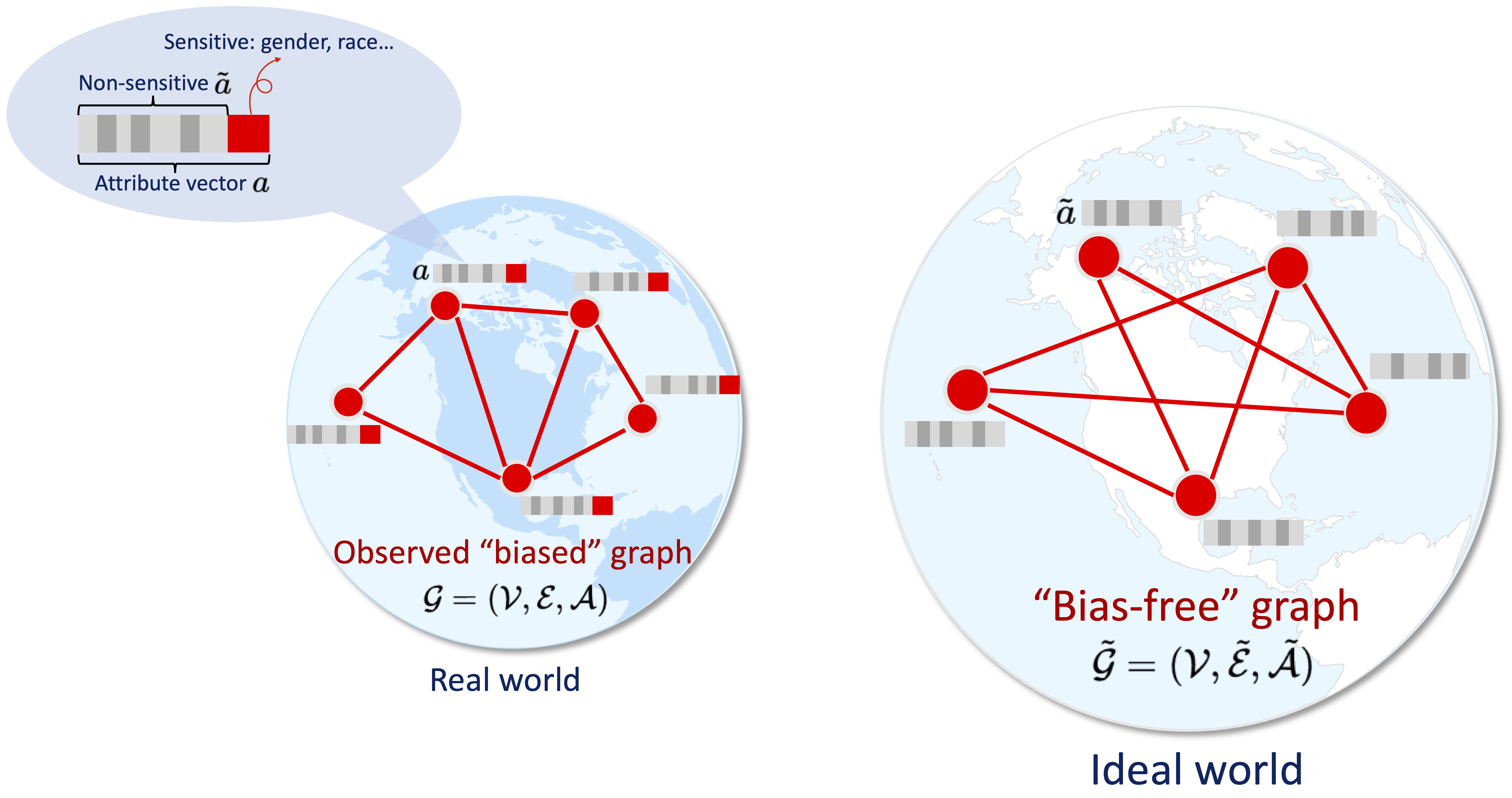This is the code for the paper "Unbiased Graph Embedding with Biased Graph Observations" accepted by WWW'22.
Unbiased Graph Embedding (UGE) is based on the idea of learning unbiased node representations from an underlying bias-free graph, where only non-sensitive attributes are involved in the graph generation. We proposed two ways to achieve that: (1) a weighting based method (UGE-W), where the weighted link reconstruction loss is calculated from the bias-free graph, in expectation. This is a sufficient condition for unbiased graph embedding. (2) a regularization based method (UGE-R), which is requiring the resulting embeddings to have the properties of those directly learned from a bias-free graph. This is a necessary condition for unbiased graph embedding. We also combined these two methods (UGE-C) to achieve sufficient-necessary condition trade-off.
Code is tested in Python 3.8 and PyTorch 1.8~1.11. Some major requirements are listed below:
torch~=1.11.0
cuda~=10.1
dgl~=0.8.1
pandas~=1.4.2
numpy~=1.22.2
scipy~=1.8.0
tqdm~=4.64.0
sklearn~=1.0.2
We include three datasets: Pokec-z, Pokec-n and Movielens-1M. Raw data are uploaded or will be automatically downloaded to ./raw_data folder. We have constructed graphs from the raw data and stored them in ./processed_data folder in unified csv format for the model to load directly.
- Pokec-z and Pokec-n are sampled from soc_Pokec following FairGNN. Raw and processed data have been already uploaded to
./raw_dataand./processed_datafolders. - Movielens-1M's raw data is too large to hold on github, and it can be automatically downloaded to
./raw_datafolder and be processed to./processed_datafolder when launching a training process.
We predefine the sensitive attributes to debias as follows, which is specified in data_loader.py.
SENSITIVE_ATTR_DICT = {
'movielens': ['gender', 'occupation', 'age'],
'pokec-z': ['gender', 'region', 'age'],
'pokec-n': ['gender', 'region', 'age']
}
To include and customize your own data, please refer to data_loader.py.
We support graph embedding models including gcn, gat, sgc, sage, node2vec. We support our proposed debiasing methods including UGE-W (weighting based), UGE-R (regularization based) and UGE-C (combined), as well as vanilla training without debiasing.
We launch run_graph_embedding.py to firstly learn the node embeddings and store the array in ./embeddings folder, then evaluate the utility (ndcg on link prediction), unbiasedness (micro-f1 on sensitive attribute prediction) and fairnss (EO/DP) of learned embeddings.
Below shows some command examples to run the code in different settings, and let us use gat model on pokec-z dataset with debiasing gender attribute as an example.
- Vanilla gat: training without debiasing.
python run_graph_embedding.py --epochs=800 --dataset=pokec-z --model=gat --debias_method=none --debias_attr=none
- UGE-W: weighting-based debiasing, which first precomputes the edge weighting by sampling snippets from the graph and store the weights to
./precomputed_weightsfolder, then trains with reweighted loss.
python run_graph_embedding.py --epochs=800 --dataset=pokec-z --model=gat --debias_method=uge-w --debias_attr=gender
- UGE-R: regularization-based debiasing, which add a regularization term to the loss with weight 0.5.
python run_graph_embedding.py --epochs=800 --dataset=pokec-z --model=gat --debias_method=uge-r --debias_attr=gender --reg_weight=0.5
- UGE-C: combining weighted and regularization based debiasing methods, with regularization weight 0.5.
python run_graph_embedding.py --epochs=800 --dataset=pokec-z --model=gat --debias_method=uge-c --debias_attr=gender --reg_weight=0.5
Seperate Embedding learning and Evaluation: ./evaluate.py also supports evaluating multiple embedding files under a folder. You can first obtain a bounch of embeddings with different hyperparameters under a folder, and run ./evaluate.py to calculate and store all the metrics into file on these embeddings.
Random baseline: directly calling eval_unbiasedness_pokec(data_name, embed_file=None) or eval_unbiasedness_movielens(data_name, embed_file=None) with setting embed_file=None in ./evaluate.py will not load existing learned embeddings but calculate the metrics of random generated embeddings.
Please cite our paper if you find this repo useful for your research or development.
@inproceedings{wang2022unbiased,
author = {Wang, Nan and Lin, Lu and Li, Jundong and Wang, Hongning},
title = {Unbiased Graph Embedding with Biased Graph Observations},
year = {2022},
isbn = {9781450390965},
publisher = {Association for Computing Machinery},
address = {New York, NY, USA},
url = {https://doi.org/10.1145/3485447.3512189},
doi = {10.1145/3485447.3512189},
booktitle = {Proceedings of the ACM Web Conference 2022},
pages = {1423–1433},
numpages = {11},
keywords = {sensitive attributes, bias-free graph, unbiased graph embedding},
location = {Virtual Event, Lyon, France},
series = {WWW '22}
}
